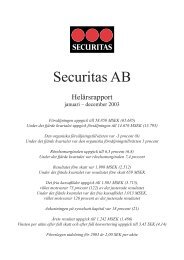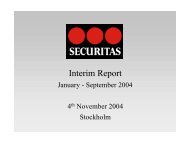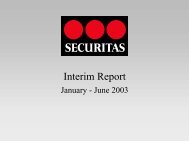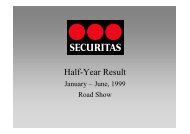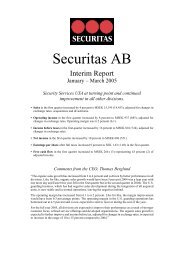Securitas AB Annual Report 2005
Securitas AB Annual Report 2005
Securitas AB Annual Report 2005
Create successful ePaper yourself
Turn your PDF publications into a flip-book with our unique Google optimized e-Paper software.
New sales of customer contracts that are added to<br />
the portfolio when the work begins.<br />
Net change in the portfolio of customer contracts,<br />
which includes new sales plus any increases in sales<br />
in existing contracts, less terminated customer contracts<br />
and reductions in sales in existing contracts.<br />
Price changes are monitored separately and added to<br />
the net change to arrive at the closing balance of the<br />
overall portfolio at the end of the period..<br />
Total sales, include contract-based sales as well as<br />
temporary assignments.<br />
Specifi cation of contract portfolio (example)<br />
Value<br />
% change in<br />
op. portfolio<br />
Opening balance 100<br />
+ New starts 15<br />
+ Increases 5<br />
– Terminations 12<br />
– Reductions 4<br />
Net change 4 +4<br />
Price change 3 +3<br />
Closing balance 107 +7<br />
Six Fingers – Effi ciency-related factors<br />
Effi ciency-related factors provide managers with instruments<br />
to monitor service effi ciency and costs. The fourth<br />
and fi fth key factors in Six Fingers are:<br />
Six Fingers – <strong>Securitas</strong>’ Financial Key Ratios<br />
Volume related<br />
factors<br />
Effi ciency related<br />
factors<br />
Capital usage<br />
related factors<br />
The Group key ratios used<br />
externally<br />
Organic<br />
sales growth<br />
Total sales<br />
Financial control and fi nancial objectives<br />
Gross margin defi ned as total sales less direct<br />
expenses in relation to total sales.<br />
Indirect expenses focus on the organizational structure<br />
and include administration, that is, expenses for<br />
branch, area and regional/country offi ces. Gross income<br />
less indirect expenses equals operating income<br />
before amortization. When this is expressed as a<br />
percentage of total sales, it indicates the Group’s<br />
operating margin, which in <strong>Securitas</strong>’ fi nancial<br />
model is shown before amortization.<br />
Six Fingers – Capital usage related factors<br />
Accounts receivable is the sixth key factor:<br />
Days of sales outstanding (DSO), payment terms<br />
and effective claim processing routines are decisive<br />
in determining how much capital is tied up in accounts<br />
receivable. These factors are continuously monitored<br />
at all levels in the organization. Although <strong>Securitas</strong>’<br />
operations essentially are not capital intensive, there<br />
are differences between the divisions. Security Services<br />
has the lowest capital requirements and Cash<br />
Handling Services has the highest. For every division,<br />
accounts receivable tie up signifi cant amounts of capital<br />
at the same time that they serve as a measure of the<br />
quality of operations. Old receivables are often a sign<br />
that other problems may exist in operations.<br />
Security Services <strong>Securitas</strong> Systems<br />
Key ratios per division<br />
Direct Cash Handling Services<br />
New sales of customer<br />
contracts<br />
Customer retention<br />
Net changes in portfolio<br />
of customer contracts<br />
Offers made, installation<br />
Offers outstanding, installation<br />
Order bookings<br />
Order backlog<br />
New sales of service<br />
contracts<br />
Net changes in portfolio of<br />
customer contracts<br />
No. of new installations<br />
Delta growth in<br />
installations made<br />
No. of monitored alarms<br />
Net changes in portfolio of<br />
customer contracts<br />
No. of new ATM’s and<br />
SafePoints<br />
No. of serviced ATM’s and<br />
SafePoints<br />
New sales of customer<br />
contracts<br />
Net changes in portfolio of<br />
customer contracts<br />
Organic sales growth Organic sales growth Organic sales growth Organic sales growth<br />
Total sales Total sales Total sales Total sales<br />
Employee turnover Cost per taken order Cash handling losses<br />
Gross margin Gross margin Gross margin Gross margin<br />
Indirect expenses Indirect expenses Indirect expenses Indirect expenses<br />
Operating margin Operating margin Operating margin Operating margin Operating margin<br />
Income before taxes<br />
Operating capital employed<br />
in % of total sales<br />
Days of sales<br />
outstanding (DSO)<br />
Operating capital employed<br />
as % of total sales<br />
Free cash fl ow Cash fl ow from operating<br />
activities as % of operating<br />
income before amortization<br />
Return on<br />
capital employed<br />
Return on<br />
capital employed<br />
Days of sales<br />
outstanding (DSO)<br />
Operating capital employed<br />
as % of total sales<br />
Cash fl ow from operating<br />
activities as % of operating<br />
income before amortization<br />
Return on<br />
capital employed<br />
Days of sales<br />
outstanding (DSO)<br />
Operating capital employed<br />
as % of total sales<br />
Cash fl ow from operating<br />
activities as % of operating<br />
income before amortization<br />
Payback time<br />
Return on<br />
capital employed<br />
Interest coverage ratio<br />
Free cash fl ow in relation to<br />
net debt<br />
Earnings per share<br />
The table provides an overview of how the model for internal reporting, Six Fingers, is linked to the external key ratios in the diagrams on page 24–25.<br />
Days of sales<br />
outstanding (DSO)<br />
Operating capital employed<br />
as % of total sales<br />
Cash fl ow from operating<br />
activities as % of operating<br />
income before amortization<br />
Return on<br />
capital employed<br />
SECURITAS <strong>2005</strong> 23




